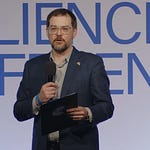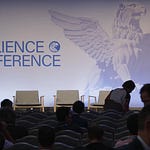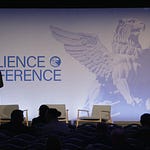Defense innovation needs a shared definition before it can be delivered. Lieutenant Colonel Timothy Otten of the Defense Innovation Unit (DIU) tried to do just that at the Resilience Conference 2025.
“We simply don’t have the luxury of thinking that all defense technology must be born inside of defense,” said Otten. “The challenge is, how do we get sharper, more practical, and more aligned with what defense innovation is and what it is not?”
Defense innovation extends beyond simple technological advancements; it encompasses a holistic approach that includes tactics, doctrine, ecosystems, and organizational structures that facilitate change. The panel emphasized the necessity of a unified definition of defense innovation, as disparate interpretations can hinder effective collaboration among government, capital, and industry.
The discussion highlighted the triad of defense innovation, which comprises government, industry, and capital. The panelists agreed that the key to effective defense innovation lies in a collaborative effort between these three pillars.
“For DIU, we anchor on one idea, which is that defense innovation is about adopting commercially derived technologies into defense at speed and scale to augment traditional defense procurements and methods,” he said. “In the US, 75% of R&D spend is outside of government. In Western Europe, that is about 60%.”
Darkstar’s Mart Noorma pushed for a focus on adoption, not slogans. “I would think it’s very clear, it’s a speed of adoption to changing reality,” he said. “It’s very important to understand that innovation in military consists of two very important parts that have to work in synergy. First, technological innovation and second, doctrinal innovation.”
He was blunt about what it is not.
“It’s not sitting and waiting for somebody else to figure it out for you,” he said. The goal is to build at home and not let America innovate and build abroad.
Shield Capital’s David Rothzeid tied progress to incentives and process.
“For me, it’s all about incentives, and I think the structures, especially around defense procurement, have the incentives in a way that drives compliance,” he said. “I don’t get rewarded because I was able to deliver things faster or that I was able to leverage third-party capital to help sort of spearhead the research and development funding necessary to deliver that prototype to the battlefield.”
From the investor side, 10D Ventures’ Alon Cantor described a familiar barrier.
“In defense, unlike commercial, there’s usually some technological function within the organization that we’re trying to sell into,” he said. “There’s the not invented here phenomenon, and they will always say, ‘We can develop it. Don’t buy it from a startup. We will develop it ourselves.’”
“We started investing in defense about a year ago, and we see this across many markets as a very strong trend,” he said.
Noorma argued for wartime-ready innovation systems that keep working under stress.
“That means all innovation processes and innovation ecosystems can run when the bombs are flying,” he said of Darkstar’s work with Ukrainian and NATO officers. His invitation was direct. “Come to Kiev with us. You’ll be in a boot camp.”
Otten closed with a test that cuts through buzzwords.
“Are we adopting the best commercial technologies fast enough to deter conflict? And if we have to fight, when? If the answer is no, then we still have work to do,” he said.









